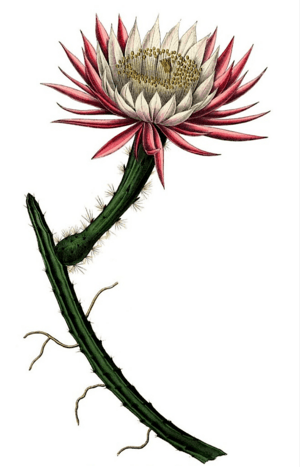Vine-like moonlight cactus facts for kids
Quick facts for kids Vine-like moonlight cactus |
|
|---|---|
 |
|
| Scientific classification | |
| Genus: |
Selenicereus
|
| Species: |
spinulosus
|
| Synonyms | |
|
Cereus spinulosus DC. |
|
The Selenicereus spinulosus is a type of cactus that grows naturally in eastern Mexico. It might also be found in the lower Rio Grande Valley of Texas in the United States. People often call it the vine-like moonlight cactus or spiny moon cereus. Its name, spinulosus, comes from Latin and means "with small spines."
Contents
Discovering the Spiny Moon Cactus
This cactus was the third type of Selenicereus ever found. A person named Thomas Coulter first collected it in Mexico in 1827. We don't know the exact place where he found it.
Later, Pyramus de Candolle received the plant in Paris. He wrote about it even though he hadn't seen its flowers. He then sent parts of the plant to Berlin. There, it finally bloomed for the first time in 1842.
Where Does This Cactus Live?
You can find the Selenicereus spinulosus cactus in eastern Mexico. It grows from a state called Tamaulipas all the way to Chiapas.
Some of these plants were also found in the lower Rio Grande Valley in Texas, USA. However, it seems this group of plants might have disappeared from the wild. People haven't seen them growing naturally there for a while.
What Does the Selenicereus spinulosus Look Like?
This cactus has long stems that can climb or spread out. They can grow up to 1 to 2 meters long, and sometimes even 5 meters! The stems are about 2 to 3 centimeters thick. They have 4 to 6 or more ribs, which become rounder as the plant gets older.
The cactus has small spots called areoles, which are about 1.5 to 2 millimeters wide. These spots are reddish-brown at first, then turn grayish-brown. The spaces between the areoles are about 1.5 to 2.5 centimeters long.
This cactus has 6 to 8 small spines, each about 1 millimeter long. They are needle-like and start out white or yellowish. Later, they turn blackish. The skin of the cactus is light green and a bit shiny.
The Cactus Flowers
The flowers grow from the areoles near the tips of the stems. They are 8 to 14 centimeters long and 7 to 8.5 centimeters wide. These flowers usually open at night. However, some people have observed them staying open for 2 to 3 days!
The outer parts of the flower are brownish. The inner parts are white, sometimes with a pink base or entirely pink. The fruit of this cactus is round and yellow. It is covered with many yellowish spines.
How to Grow This Cactus
It's quite easy to grow the Selenicereus spinulosus cactus. Plants about 1 meter long can start to flower.
You should give this cactus some shade or full sun. It grows best in soil that has a lot of peat. When the plant is growing, it needs plenty of water and regular plant food. It grows quickly and flowers often.
During winter, you can keep the plant at about 5 degrees Celsius (41 degrees Fahrenheit) if you keep it dry. This cactus is known as the easiest Selenicereus species to make bloom when you grow it at home.
Interesting Cactus Mixes: Hybrids
People have created new types of cacti by mixing Selenicereus spinulosus with other plants. These are called hybrids. Here are a few examples:
- Pimiento (Created by Sherman E. Beahm in 1955): This hybrid is a mix of S. spinulosus and Disocactus 'Tulip'. It has wide-open flowers that are red, getting darker at the edges.
- Sacred Ox (Created by Dr. Robert Poindexter in 1943): This plant is a mix of S. spinulosus and 'Scarlet Giant'. Its flowers have white inner parts and pink and yellow outer parts.
- Twinkle (Created by Dr. Robert Poindexter): This is another mix of S. spinulosus and 'Scarlet Giant'. It has wide-open flowers that are salmon orange, very similar to a hybrid called 'Gloria'.
- Tululosa (Created by Beahm in 1947): This hybrid is a mix of S. spinulosus and Disocactus 'Tulip'. It has straw-orange flowers with lavender edges and blooms at night.
See also

- In Spanish: Selenicereus spinulosus para niños
Images for kids



